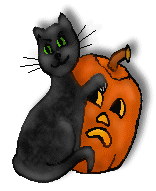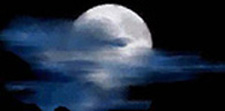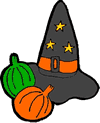


Family Network


|


Family Network


|
|
History of Witchcraft, Witches Around The World.

Halloween Traditions  Halloween in Britain
In some parts of Britain Hallowe'en in the past was known as Mischief Night. It was a night for mischief making. People would take the doors off their hinges on this night. The doors were also often thrown into ponds, or taken a long way away. In England it is said that elves road on the backs of the villagers' cats. The cats had fun but the villagers did not and would lock their cats up so that the elves could not catch them. Children were told not to sit in the circles of yellow and white flowers were fairies have danced as they may be stolen by the fairies. It was also bad to sit under the hawthorn tree because the fairies loved to dance on them and if they saw them their tempers would be prickled. In England the black cat was considered to be good luck were as a white cat was considered to be bad luck. In England children make "punkies " out of large beets. They cut out a design of their choice into the beet. Then they carry them through the streets and sing the Punkie Night Song. They knock on doors and ask for money. In some parts of England turnip Lanterns are place on gateposts to protect homes from the spirits. In England Halloween was nicknamed, Nutcracker Night or Snap Apple Night. Families would sit before a great fire in the hearth, roasting nuts and eating apples. They told stories and played holiday games. It was an evening of great fun and merriment. In England they continued to practice their deep-rooted, ancient pagan rites well after the arrival of Christianity in the middle of the sixth century. The Church fathers had become concerned that the popularity of non-Christian festivals was growing at the expense of Christian holy days. Pope Gregory I, in 601 issued a decree to his missionaries about the faith and customs of the people whom he wanted to convert to Christianity. Gregory knew that it would be impossible to eradicate the beliefs of the natives totally and so suggested to his priests that they "convert" them whenever possible. If the native people worshipped at a well, or sacred grove, Gregory informed his missionaries to enshrine them to Christ and let the worship continue. Gregory's successor Pope Boniface IV in 609, declared May 13 All Saints' Day. Unfortunately, while pagans were happy to add All Saints' Day to their calendar, they were unwilling to give up their existing festival of the dead and continued to celebrate Samhain. Intent on eliminating the ongoing power of the pagan beliefs, Pope Gregory III followed in the footsteps of the earlier Christian leaders and intentionally united the Christian All Saints' Day to the festival of Samhain. He then moved All Saints' Day to November 1, which became more commonly known as All Hallows. Because Samhain had traditionally fallen the night before All Hallows, it eventually became known as All Hallows' Even' or Hallowe'en. Previous church leaders to Gregory III discouraged the Samhain tradition of wearing frightening costumes, but Gregory decided instead to allow people to dress up in honor of the saints. Other traditions, such as begging for food and kindling, were made legal by the Church, providing that any food that was given to the beggars would be given to the poor, rather than to appease the spirits. The Church also added a second day to the festival, this fell on November 2 and was called All Souls' Day and was dedicated to the souls of those who are still left in purgatory. These souls had to endure the punishment of purgatory for their sins. It was believed that the lighting of candles and the saying of prayers for the dead would shorten the time they were to suffer in purgatory before they would rise to heaven. The Tradition of begging for food soon was replaced with souling or Soul Caking. The idea was for children to go from door to door asking for money to give to the poor and a soul cake to have for themselves. Every cake they would receive, the children would say a prayer for the souls of the dead. Soul cakes were called many different names throughout England such as Saumas or soul mass cakes which were dark fruitcakes, another cake was covered in caraway seeds and made into a bun. In the North of England the tradition of lighting bonfires was central to the Halloween celebration. Superstition was still strong as a result of the aftermath of the witch-hunts; witches were believed to take to the air to harass everyone at Halloween. Halloween was called Tan Day for the township of Lancashire. Tan day was so named as it was the Celtic tein, or fire and pitchforks full of burning hay were flung into the air to scare the witches. Another reason was the heat and the smoke of the bonfires would also drive away any airborne witches.
  
Mens.Net | Womens.Net | Mothers.Net | Fathers.Net | Grandparents.Net | Teenagers.Net | Santas.Net | EasterBunnys.Net | JackOLanterns.Net | FatherTimes.Net | StValentines.Net HarvestFestivals.Net | BirthdayCelebrations.Net | ToothFairys.Net
 Please read our Legal Statement and Privacy Policy.
|